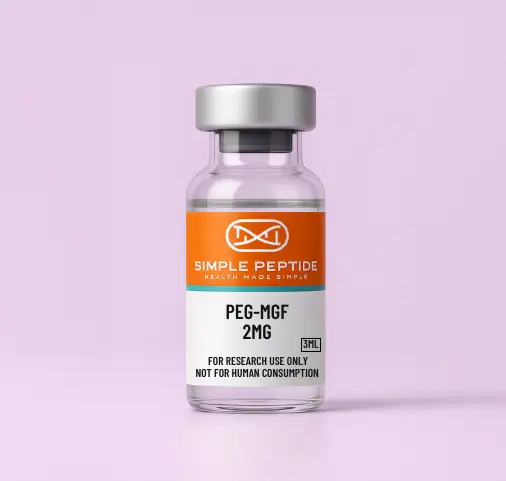Cartilage and connective tissues are some of the main components of the musculoskeletal system. They help provide structural support, flexibility, and shock absorption. However, their restricted regenerative capacity is a considerable challenge in treating injuries and degenerative conditions like arthritis. PEG-MGF (Polyethylene Glycol-Modified Mechano Growth Factor) has emerged as a promising tool in regenerative medicine, offering potential benefits for cartilage and connective tissue repair. This article explores the mechanisms, effects, and therapeutic implications of PEG-MGF in these tissues.
PEG-MGF Explained in Detail
PEG-MGF is a synthetic derivative of Mechano Growth Factor (MGF), a splice variant of Insulin-like Growth Factor-1 (IGF-1). MGF is naturally expressed in response to mechanical stress or tissue injury and is critical in cellular proliferation, migration, and repair processes. However, its rapid degradation limits its therapeutic potential. PEGylation, the attachment of Polyethylene Glycol (PEG) to MGF, enhances its stability, bioavailability, and half-life, making it suitable for systemic applications in tissue regeneration.
Modifications with PEG extend the duration of action and reduce immunogenicity, which is crucial for minimizing adverse reactions in clinical settings. This makes PEG-MGF an attractive candidate for long-term therapeutic strategies promoting tissue repair and regeneration.
Mechanisms of Action in Cartilage Regeneration
Cartilage regeneration involves chondrocytes (cartilage cells), extracellular matrix deposition, and anti-apoptotic mechanisms. Research suggests that PEG-MGF may enhance chondrocyte activity and migration, which is crucial for maintaining cartilage integrity. Key mechanisms include:
- Chondrocyte Proliferation: PEG-MGF stimulates cellular proliferation by activating IGF-1 receptors and intracellular signaling pathways such as Akt/mTOR. This promotes the expansion of chondrocyte populations needed for matrix synthesis. The activation of these pathways also supports the differentiation of stem cells into chondrocytes, further enhancing cartilage repair.
- Matrix Deposition: Studies indicate that PEG-MGF facilitates glycosaminoglycan (GAG) deposition within cartilage scaffolds. GAGs are essential components of the extracellular matrix that provide structural strength and elasticity. By promoting the synthesis of these critical matrix components, PEG-MGF helps restore the mechanical properties of damaged cartilage.
- Anti-Apoptotic Effects: PEG-MGF appears to reduce apoptosis in chondrocytes under mechanical stress by modulating pathways like p38 MAPK. This ensures cell survival during tissue repair processes, maintaining the viability of chondrocytes necessary for sustained cartilage regeneration.
Effects on Connective Tissue Repair
Connective tissues such as tendons and ligaments are characterized by slow healing due to limited blood supply and cellular turnover. PEG-MGF has shown promise in accelerating repair by influencing fibroblast activity and extracellular matrix production. Specific effects include:
- Fibroblast Proliferation: Fibroblasts are key players in connective tissue repair. PEG-MGF enhances their proliferation and differentiation, improving collagen synthesis and structural remodeling. This is particularly important in tendons and ligaments, where collagen fibers provide tensile strength.
- Enhanced Healing: By recruiting macrophages and neutrophils to injury sites, PEG-MGF supports the inflammatory healing phase while promoting tissue regeneration. This balanced approach ensures that effective tissue repair mechanisms follow the initial inflammatory response.
- Integration with Host Tissues: Research on hybrid scaffolds incorporating PEG suggests improved integration with native tissues, making them valuable tools for surgical interventions. This integration is crucial for ensuring that repaired tissues functionally and structurally resemble their healthy counterparts.
Medical Applications of PEG-MGF
The regenerative properties of PEG-MGF have opened avenues for its application in various medical conditions:
Arthritis
Degenerative joint diseases like osteoarthritis involve cartilage breakdown and inflammation. PEG-MGF may mitigate these effects by enhancing chondrocyte function and reducing apoptosis, potentially slowing disease progression. PEG-MGF could offer a novel therapeutic strategy for managing osteoarthritis symptoms and improving joint function by promoting cartilage repair.
Tendon and Ligament Injuries
Sports injuries often damage tendons and ligaments. PEG-MGF’s ability to stimulate fibroblast activity makes it a promising candidate for accelerating recovery in these tissues. Faster healing times could significantly reduce downtime for athletes and improve overall outcomes in musculoskeletal injuries.
Post-Surgical Recovery
PEG-GH hybrid scaffolds have demonstrated good integration capacity with host tissues, suggesting their use in post-surgical cartilage repair procedures. This could enhance the success of surgical interventions by promoting more effective tissue regeneration and integration.
Conclusion
PEG-MGF represents a significant advancement in regenerative medicine, offering promising results for cartilage and connective tissue repair. By enhancing chondrocyte activity, fibroblast proliferation, and matrix deposition while reducing apoptosis, it addresses key challenges in tissue regeneration. Although further research is needed to overcome existing limitations, PEG-MGF holds great potential for treating degenerative conditions like arthritis and accelerating recovery from injuries.
As scientific understanding progresses, PEG-MGF may become integral to regenerative therapies to improve musculoskeletal health and quality of life. Its integration into clinical practice could revolutionize the treatment of musculoskeletal disorders, providing new hope for patients suffering from chronic conditions.
In this context, businesses like Simple Peptide play an essential role by supplying high-purity research peptides like PEG-MGF to scientists who are exploring its therapeutic applications further. Their contributions help drive innovation in regenerative medicine while supporting advancements that could transform patient care worldwide.

Leave a Reply
You must be logged in to post a comment.